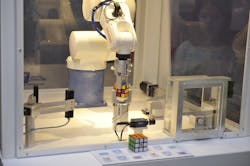Ethernet-based fieldbuses have been helping to boost the percentage of robotic applications that use vision. “It’s really about the ease of data transmission,” explains Greg Raciti, engineering manager at Faber Industrial Technologies, a distributor and system integrator. “Being able to interface with various manufacturers’ hardware in a universal fashion has proven invaluable for transferring an object’s positional data for picking or the results of its inspection measurements.”
Raciti points to the Sherlock software interface on the PC-based vision systems from Teledyne Dalsa. “You can even map certain registers, which makes it that much easier to exchange data,” he says.
Besides streamlining the machine-to-machine communications within the application itself, the software and Ethernet port help his staff to provide remote technical support. “Our biggest challenge is a lack of internal engineering support at many of our customer sites,” Raciti reports. “Although combining vision and robotics has become much easier over the past decade, it still requires a solid support staff to maintain it after we turn over the keys.” The support staff might also need the competence to configure the robot and vision system to process any new parts or tasks that could come along later.
When the support staff needs a little help, engineers at Faber can offer some remotely over Ethernet ports on the vision PC. In fact, they provide all of the technical support this way for a traveling exhibit that they built for the Liberty Science Center in Jersey City, N.J. Because the center and the various institutions hosting the exhibit are museums, they have no one on staff qualified to maintain the technology in the exhibit commissioned to celebrate the 40th anniversary of the Rubik’s Cube.
In the exhibit, a six-axis Denso robot unscrambles Rubik’s Cubes within a minute based on input from two GigE Teledyne cameras. Once a visitor places his or her cube into a nest and closes the door, the first camera performs a shape check to verify that the object is a standard-size cube. After verification, the cube goes into the work zone, where the robot grabs it with a pneumatic two-jaw gripper and shows all six sides to the second camera. Based on the data collected, the vision software creates a color map, and a public-domain algorithm generates a plan for unscrambling the cube within 20 moves. “We tweaked the algorithm to translate the answer into robot moves,” Raciti says.
His engineering staff programmed the robot to perform with a bit of flare to delight audiences. As the PC crunches the numbers to solve the cube, the robot goes into a 20-second dance, waving the cube to the crowd. “It shows off before it starts solving it,” Raciti says. As the robot manipulates the cube, a screen in the corner shows a countdown and tracks the remaining number of moves. “After solving it, it goes into another little celebration dance that includes a fist pump.”
After solving 67,000 cubes during its inaugural year at the Liberty Science Center, the robotic exhibit embarked upon a seven-year tour. Right now, it is at its first stop, the Great Lakes Science Museum in Cleveland, but will make its way to Budapest, the hometown of Erno Rubik, creator of the cube. To provide support along the route, Faber’s engineers log onto the vision PC remotely to gain access to the exhibit’s Ethernet network. Web cams that they built into the exhibit let them see the robot as they help it to recover from errors.
For more about how machine vision is expanding robotic capabilities and applications, see “Vision-Guided Robots Look at Growing Tasks.”
About the Author
James R. Koelsch, contributing writer
Contributing Editor

Leaders relevant to this article:
